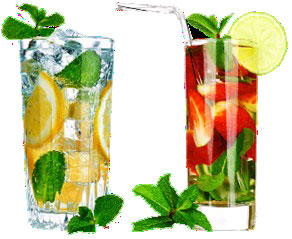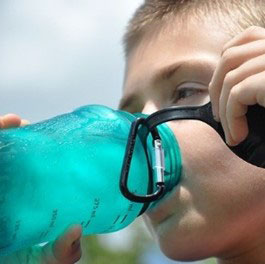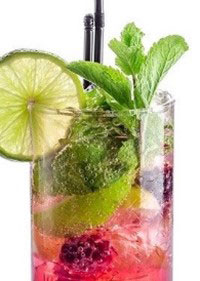Cool Down with Refreshing, Flavor Infused Water
By: Nicole Clark, Family & Consumer Science Agent, La Plata County

Outdoor play, yard work, and other physical activity during hot summer days can lead to dehydration. As we sweat to cool our body, we quickly lose water. Young children and older adults have an increased risk for dehydration. Furthermore, roughly 20% of children do not drink enough water in a given day. With increased loss of water and decreased intake of water, the risk for dehydration increases.
Fruits, vegetables and herbs, creatively combined, can add flavor to water. This can encourage drinking more fluids, without unnecessary calories from sugar.
Build a Better Beverage and Stay Hydrated
- Fizzy or flat? Decide on your preference for water, with or without bubbles. Club soda contains minimal sodium (75 mg/12 oz.) which may help replenish electrolytes lost through sweat.
- Temperature preference. Room temperature, cool, or cold. Choose one that you find satisfying.
- Fruit ice cubes. Puree any fruit and freeze it in an ice cube tray. Fruit ice cubes add an appealing color and flavor, plus it chills your bev-erage.
- Bright flavor. Fruits with stronger flavor will make water more fla-vorful. These include grapefruit, pineapple, kiwi, orange, lemon, lime, tart apple, raspberries and pomegranate. Slice thin, or crush, to increase surface area.
- Herbs & spices from the kitchen. You are kind of making tea, but with new and exciting flavors. Culinary lavender, rosemary, basil, ginger, mint and tarragon taste great with fruit and vegetables.
- Vegetables. Thinly sliced cucumbers, fennel and celery add a cooling aspect to your drink.
Tips, Beyond Flavor, to Increase the Amount of Water You Drink

Enjoying the taste of your beverage is one thing. Getting it to your lips is another. When feeling thirsty is not enough, you may need to use other techniques to help you remember to drink.
- Hydration apps. Try a free hydration app to remind you, and your children, it’s time for water. Aqualert, Plant Nanny, Daily Water – Drink Reminder and Waterlogged are free and available on Android and iOS. They are available in multiple languages.
- Make it visible. Place a clear water bottle where you can see it. Seeing how much water is in the bottle is a visual reminder of how much you’ve had to drink. Drawing lines on a water bottle creates a fun hydration challenge/goal for kids. Use a dry erase marker.
- Make it accessible. If you tend to forget water, keep reusable and filled bottles in all of your favorite places such as the car, backpack, bedroom, or office. Purchasing vacuum insulated water bottles will help hold cool temperatures longer.
- Get water from the food you eat. If all else fails, be sure to include water rich foods in your diet. Fruits, vegetables, soup (hot and cold), yogurt and smoothies are all good options.
Let’s Talk
Getting a child busy at play to stop and drink water can be a challenge, so make it fun and role model the behavior.
- Set an alarm on your phone (or hydration app) to signal a water break.
- Incorporate play, if your child was running ask how many gulps of water a cheetah needs. If they were swimming, ask how many gulps of water a dolphin needs. While playing at the park, how many gulps of water does a monkey need? Encourage them to drink as many gulps as the animal would.
- Improve your child’s self-awareness by asking a few questions. Do they have a dry tongue and mouth? How does their head feel? Ask them to rate their energy on a scale of 1 – 10. Have them rate their energy again a few minutes after they’ve had a beverage.
Recipes for Health

Refreshing, Low-calorie Beverages Your Children Can Help Make
Start by washing hands and food contact surfaces with soap and water. Rinse all produce under running water. Place rinsed fruits, vegetables and herbs in a reusable mesh/tea bag and add to 32 ounces of water. If you do not have a mesh or tea bag, place plant material directly in water and strain plant material from water before consuming. Plant amounts can be adjusted to your liking. Allow 1+ hours for infusion. Store infused water in the refrigerator and use within 2 – 3 days. Fruits and veggies can be eaten after being strained.
- Raspberry-lemon-mint ice cubes. Blend 16 ounces raspberries (fresh or frozen), 1/4 cup lemon juice + 10 ounces water. After blending, stir in 2 tablespoons chopped fresh mint leaves. Pour mixture into ice tray and freeze.
- Cucumber, lime & basil water. Wash one large cucumber. Cut in half crosswise (NOT tip to tip) and peel one-half (save other half for later). Slice cucumber into 1/4” slices. Add sliced cucumber, 1/4 cup lime juice and 6 large basil leaves.
- Pomegranate, kiwi & lavender. Combine 1/3 cup pomegranate seeds (lightly crushed), and 2 – peeled and sliced ripe kiwis, plus 1 tablespoon culinary lavender. Culinary lavender does not have added scents and is safe for eating.
- Build your own! What do you have available in your kitchen? Look in the fridge, freezer, and pantry. Canned fruit with a splash (1- 2 tablespoons per 8oz. water) of the juice or syrup can be a great way to start the transition to no-calorie beverages. Experimenting is half the fun!





